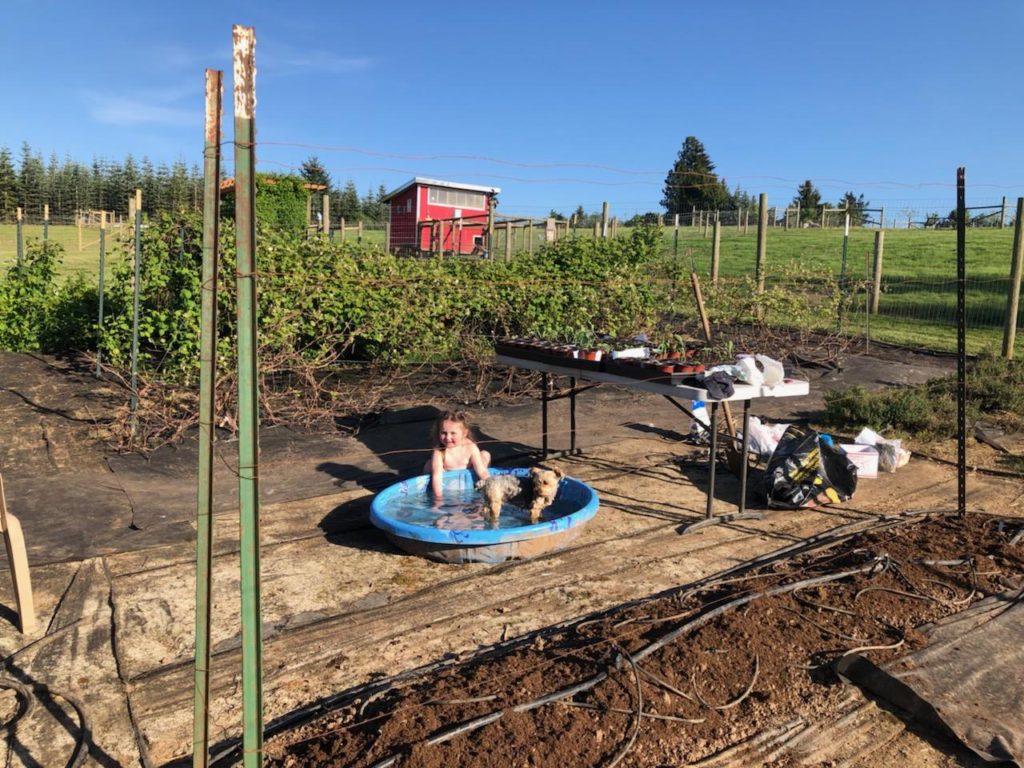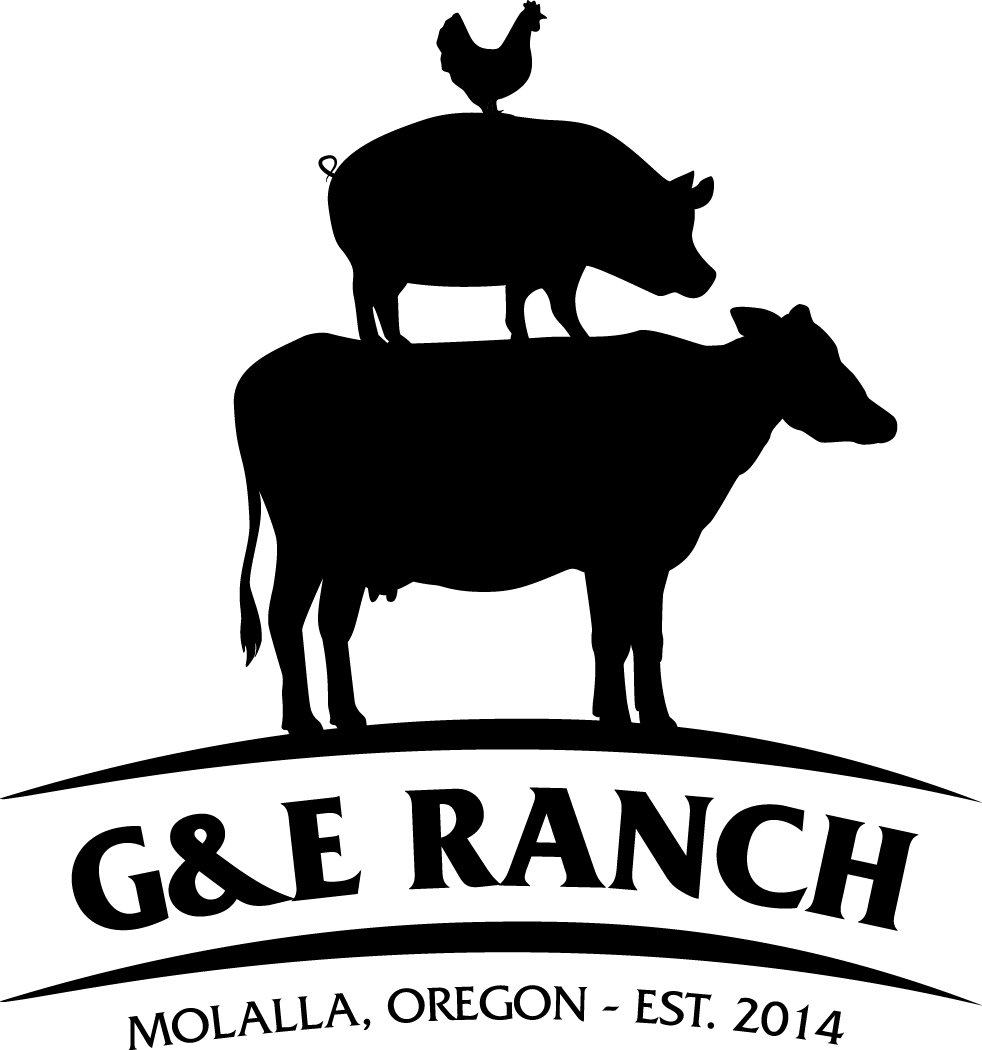The G & E Ranch has a wonderful 5,000 square foot fenced garden. The space was initially created on pasture by covering the grass with fabric and cardboard for 6 months and tilling in 100’s of yards of composted horse manure. The garden has 22 mounded beds that are filled with vegetables and herbs each year. It also includes a row each of grapes, gooseberries, blueberries, raspberries, and marionberries. The garden was built near the pasture so that any excess vegetables can be thrown over to the animals as food. The garden has been a work in progress over the years. Each year, we make modifications and improvements to reduce weeds, increase production and automate the water irrigation.
Over the last four years, we have added automatic water to each bed and made necessary adjustments. Automatic irrigation systems sound great, and they are…. when working correctly. Every year, repairs must be made due to broken lines, fittings, emitters, valves, etc. that are caused by freezing or rodents. After repairs are made each spring, every emitter in every bed must get tested. When the system was first designed, it was on one timer. Due to water pressure and volume, we adjusted the garden to have additional zones, eventually landing on 5 zones today. With our garden sharing water with the orchard, and six other automatic animal watering stations, there are thousands of fittings and over a mile of poly pipe.

Every year, the plants or seeds need to be organized according of the type of watering system in each bed. For example, tomato plants need a single emitter at their bases, and a bed of lettuce requires soaker hoses spread throughout. You may wonder why we don’t just plant the same thing in each bed every year. We practice rotational and companion planting to improve the soil conditions. Each plant takes and gives back different nutrients from/to the soil at different rates, so by rotating or companion planting, we are helping the soil conditions be more nutrient-rich for the plants to thrive. In the fall after the last harvest, we strip the garden of plant material for animal feed and composting, and we plant a cover crop. This protects the soil from winter weeds and erosion, and it also naturally fixes nitrogen into the soil.
We typically try to plant seeds in the house early spring when it is still cold outside, then transfer them to the garden when the weather changes. Well, we have not had the best of luck with this. The first year we tried, Greg was working out of town and Emily had to water them during the week. You may not know, but Emily cannot keep any vegetation alive, so that was a fail. Last year, we chose not to plant seed starts in the house ahead of time and instead put the seeds straight into the ground when we thought it was time. Well, we were too early. They froze, and we had to replant everything. This year, we planted the seeds in the house too early, and many had to be replanted into bigger containers. Our kitchen had cookie sheets all along the bar with an additional 6-foot camp table added in the dining room. Eventually, we transitioned them all outside to get better natural light. The shock from the cool nights killed every plant, forcing us to start over. We have decided going forward, and until we get a greenhouse (if ever), it is worth the money to save the time (and our kitchen space), and buy starts from the professionals. Unless plants require direct burial, we will buy the beautiful plant starts from the local nursery.

We have our staples that we like to plant, and then every year try to throw a few wildcards in the mix. Staples include lettuce, tomatoes, zucchini, cucumbers, beans, and pumpkins. A couple of our past wildcards that have become staples are cabbage and potatoes. This year’s wild card is eggplants and large onions. We typically try a few peppers, but our climate in the Pacific Northwest isn’t hot enough for them to flourish. We have planted beets several years, and they grow great, but the gophers, moles and voles get to them before we do. Our goal is just to have a fun variety.
So, you might ask, what do we do with all the produce? Well we eat as much fresh produce as we can. We give away some to friends and family, typically for trade to help us on the farm. Any produce that is damaged or has spoiled gets tossed to the animals as food. Finally, produce is preserved in some fashion. We have made and canned things like salsa, tomato soup, squashes and catsup. We have also pickled things like cucumbers and fermented things like living sauerkraut. Eventually, we may get good enough to start a small CSA (community supported agriculture).
Our latest challenge with the garden is rabbits. They have never been an issue before, but they recently did some serious damage to our fruit orchard, so we are not taking any chances with the garden. We have put chicken wire along the bottom two feet of the fence to insure they cannot get in (or at least slow their progress). Then, we installed a 2×4 boarder along the ground to staple the fencing to it. After we bury the high spots, we hope to be safe from those cute little pesky rabbits. Otherwise, we may have to go Mr. MacGregor on these bunnies. We are also continuously fighting off the underground rodents with a myriad of control devices.
At this point we have everything in the ground, the water is working, and we are excited to see what our 2019 crop looks like.

Thanks Coach
really good info 🌱
Thanks bib sis! I’m looking forward to your visit soon!
Ed,
Congratulations on retiring! You put in a lot of years and earned it. I personally haven’t worked with YMC, but I’m sure our team in Boise has. I’m sure you have some grand adventures to share since you have more time for yourself???